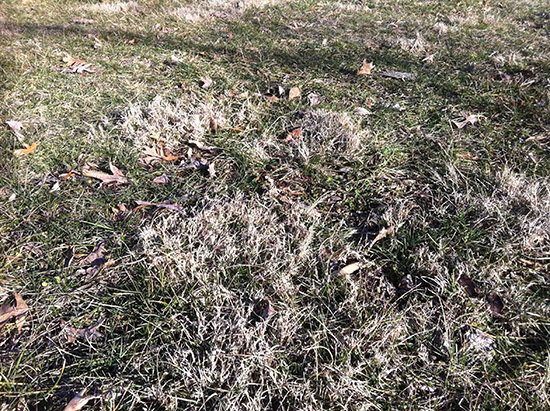Issue 1, April 11, 2016
Nimblewill
Nimblewill, Muhlenbergia schreberi, is a warm-season perennial grass, thriving in summer's heat, but like zoysia and bermudagrass, looking straw brown from late fall thru spring. It's one of the last warm season grasses to green up, often causing worries that areas of the turf have died.
During the summer when actively growing, it forms one to two feet diameter clumps with an olive to bluish-green color, contrasting noticeably with bluegrasses, fescues and ryegrasses.
Unlike the cool season lawn grasses with elongated blades, nimblewill has a wiry appearance that almost seems branchlike, with the thin hard stems growing upright until they fall over, resulting in horizontal growth except for the tips which resume vertical growth. The stolons help it creep across the top of the soil, but these loosely attached horizontal stems can be pulled up easily.
For identification purposes, the ligule is slightly membranous with a few fine hairs.
During the winter, the brown patches resemble dead spots. However, if you pull up a plant and peel back the brown leaves and stems, you can find the green growing tissue. Warm May weather usually causes the grass to green.

Nimblewill is common in park settings, where the summer color isn't as problematic as it might be in a home yard
Nimblewill thrives in poorly drained soil, and in sunny or shady areas.

Increasing the vigor of the surrounding turf through proper watering, fertilizing, including the use of winterizers, and mowing can reduce the nimblewill patch size. Aeration promotes better drainage. Stimulating cool-season grasses in the fall when the nimblewill has browned can reduce patches the following spring.
Hand digging and pulling may be practical for small patches.
Only Tenacity (mesotrione) is currently labeled for selective control in cool-season yards. Several applications may be needed, and labeled rates must be followed to avoid damaging the bluegrass, ryegrass or fescue turf. Tenacity causes the affected grass to appear bleached.
Glyphosate products such as Roundup can be used for non-selective control, though these products can damage the desirable turf. Glyphosate must be applied to actively growing plants, and won't have an effect on the nimblewill until it greens up. (David Robson)
Author:
David Robson